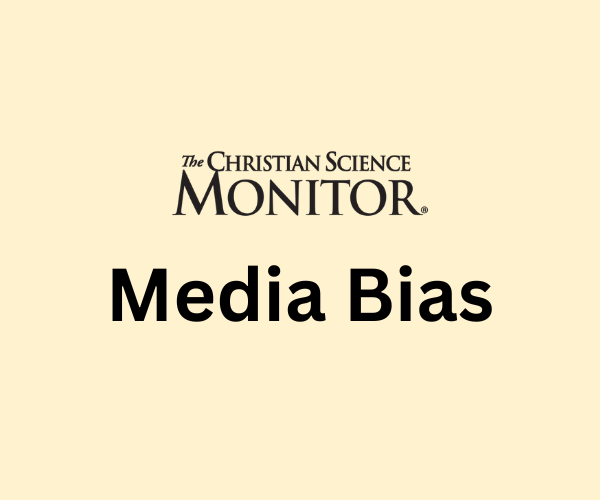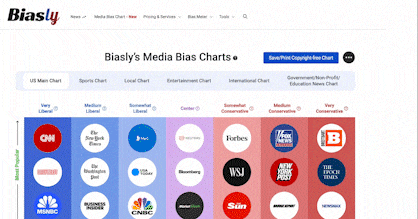
The Christian Science Monitor is a respected news publication known for its in-depth, unbiased reporting and thought-provoking journalism. The Monitor was established to provide informative and constructive news while promoting understanding and dialogue on important issues, reflecting a commitment to Christian Science principles, which emphasize spiritual understanding and healing. However, it has faced criticism for its coverage of political events, particularly during election cycles. Some critics argue that its reporting may lean toward a particular ideology. Additionally, there are debates regarding its portrayal of certain countries and conflicts in its international reporting.
In this article, we will examine the newspaper’s coverage and editorial choices to identify any potential biases in their articles. By equipping you with these tools, we aim to provide a comprehensive analysis that will help you determine whether a news outlet is biased.
How Does Biasly Rate News Sources?
Biasly’s algorithms produce bias ratings to help provide multiple perspectives on given articles. Biasly has analyzed 200,000+ news articles from more than 3,200 news sources through our A.I. technology and team of political analysts to find the most factual, unbiased news stories.
Biasly determines the degree of political bias in news sources by using Biasly’s Bias Meter Rating, in which Biasly’s team analyzes media sources’ reliability and bias and produces three scores, a Reliability Score that measures the accuracy of media sources; an A.I. Bias Score, evaluated by A.I.; and an Analyst Bias Score evaluated by political analysts. These scores are rated based on seven rating metrics including Tone, Tendency, Diction, Author Check, Selection/Omission, Expediency Bias, and Accuracy. These metrics help our analysts to determine the political attitude of the article.
Our A.I. machine-learning system employs natural language processing and entity-specific sentiment analysis to examine individual articles and determine their bias levels. By analyzing the key terms in an article such as policies, bias phrases, political terminologies, politicians, and their nicknames, the algorithms can rate the attitude of the text. Bias scores range from -100% and 100%, with higher negative scores being more liberal and higher positive scores being more conservative, and 0% being neutral.
Is CS Monitor Politically Biased?
Biasly’s rating for CS Monitor gives the paper a Computer AI Bias Score of Center-Left, a score generated by its AI-based algorithms. Biasly’s AI bias analysis focuses on the leaning of tone, opinion, and diction of the author, and their respective tendencies. For example, Biasly has rated its stance on policies such as Anti-Discrimination Laws and Government Interference as centered. It also covers politicians with varied sentiments, such as projecting Bill de Blasio in a positive light while painting Chuck Schumer negatively. In these rankings, politicians are evaluated based on their policies and statements rather than their ideological beliefs.
Biasly has assigned a Somewhat Liberal as an Analyst Bias Score. Typically, alongside the Computer Bias Score, Biasly presents an Analyst Bias Score. This score is curated based on a review of at least 15 articles by a team of analysts representing liberal, moderate, and conservative viewpoints. Different types of bias in articles, preferences for liberal or conservative politicians and policies, all factor into generating these scores. The more articles the Biasly analyst team reviews and rates, the more precise the analyst score becomes.
Before we begin, we need to discuss bias. Bias is a natural function of humans, and we can express it both consciously and unconsciously. Bias is one of the most fundamental forms of pattern recognition in humans. This isn’t to lower the bar and say that “all things are biased,” but to explain the process in which we may come to trust certain news organizations that display patterns of coverage.
On the media’s part, there is an incentive to retain audiences, encourage them to purchase subscriptions, and rate products positively. Bias is a two-way street, people want to see news stories about things they care about, and the media needs viewers to continue their operations. This creates a positive feedback loop that influences what stories are covered and from what perspective. This also explains the actions of more liberal news organizations.
Analysis of Bias in CS Monitor Online Articles
The Christian Science Monitor primarily serves an older audience, with many of its readers being middle-aged or seniors. According to SimilarWeb, about 55% of its daily website visitors are male, while 45% are female. Known for its high-quality journalism, The Christian Science Monitor attracts highly educated readers, many of whom hold college degrees and have interests in politics, science, culture, and religion. Although most of its readership is based in the United States, the publication also has a substantial international audience thanks to its global perspective, which appeals to those interested in international affairs. While it is affiliated with the Christian Science Church, its readership is diverse regarding religious beliefs.
How does the CS Monitor ensure its impartial content appeals to both liberal and conservative readers in the US and worldwide?
When determining bias, some of the most common metrics used include Tone, Tendency, Author, Diction, and Expediency Bias, which are the primary metrics we’ll focus on below.
- Tone: This represents the attitude of the writing, formed distinctively but related to the author’s word choices or diction.
- Diction: The specific words chosen by the writer.
- Author: A metric related to the article’s author, taking into account their history of stance on issues based on past articles and social media posts.
- Tendency: measures how consistently an author shows bias in their work, including factors like their tone and perspective.
- Expediency Bias: relates to the immediate impression created by elements like the article’s headline, images, or summary, indicating if they favor a particular viewpoint.

Source: CS Monitor
An example of this is “Second Amendment rights for abusers? Justices seem skeptical”. The expediency bias lies within the image of Former United States Representative Gabrielle Giffords standing outside the Supreme Court surrounded by a group of supporters, primarily women, holding protest signs against gun violence and domestic violence. The article’s headline creates a strong emotive impression that the Supreme Court justices are questioning the appropriateness of extending the Second Amendment rights to individuals with a history of abuse.
The author’s tone in the article is informative and analytical. It offers a detailed overview of the Supreme Court case and the arguments presented by the justices. Additionally, the tone is somewhat critical, as it questions the practicality and implications of applying historical traditions to modern gun regulations.
“In 2022, in New York State Rifle & Pistol Association v. Bruen, the court expanded that protection to carrying a firearm anywhere in public.”
The author’s diction is formal and informative, using complex sentence structure and legal terminology. The language is precise and technical, reflecting a deep understanding of legal concepts and the nuances of the cases.
“The Supreme Court today appeared skeptical that the Constitution protects the right of a domestic abuser to possess a firearm.”
This example illustrates how the author uses specific and authoritative language to convey the gravity of the Supreme Court’s deliberations.
The author’s tendency appears to be to present a neutral perspective on the Supreme Court’s consideration of the Second Amendment right to possess firearms in the context of domestic abuse. Using an informative tone, the author provides a detailed account of the oral arguments and the justice’s viewpoints while showing a clear bias in favor of one side.
Henry Gass is a staff writer and Texas correspondent for the Monitor. His X (Twitter) profile does not indicate any personal political biases. Instead, his feed primarily features his reports on Texas news, U.S. politics, and contributions from other CS Monitor correspondents and journalists.
The presidential race comes to Texas today, but the state is most important for the future of the Senate.
The state “has been trending Democrat. Is it there yet? I don’t think so,” says @JessicaTaylor. “Those last few points are incredibly hard to get.”https://t.co/w1BNdNCSb1 pic.twitter.com/J1uemhqmcC
— Henry Gass (@henrygass) October 25, 2024
“I believe Joe Biden will do it.” An Indigenous leader in Canada, on the importance of #apology, told us he always believed the U.S. would follow Canada’s example by apologizing for #NativeAmerican boarding schools. @henrygass @rirob111 https://t.co/7GqHCcWIG5
— Sara Miller Llana (@sarallana) October 25, 2024
Analysis of CS Monitor Opinion Articles
Before addressing this question, it is important to distinguish between reporting and opinion. Reporting aims to be neutral, presenting facts and quotes from primary sources so that readers can form their own opinions. In contrast, opinion articles provide columnists with a platform to share their personal views on current issues. While the Christian Science Monitor (CS Monitor) strives to maintain neutrality as a publication, it does have an Opinion section where columnists can express their perspectives. However, this section is significantly outdated, with the last article published in 2014.
Consider the opinion article published in 2013, “America is not the world’s policeman – in Syria or Iraq”. The title’s language is assertive and definitive, suggesting a critique of America’s historical role in foreign interventions and calling for reevaluating its global responsibilities. The metaphor of a “policeman” implies that the U.S. has positioned itself as an enforcer of international order, which can lead to overreach and unintended consequences.
In the article, the author argues:
“I do not go along with the statement by the US that “it is too late” for Syria now to cooperate. That is a poor excuse for taking military action.”
“But now it is President Barack Obama, not George Bush, taking on the role of world policeman?”
“As far as they are all concerned, a criminal act has been committed so now they must engage in what they call “retaliation.” I don’t see what they are retaliating about.”
“China and Russia will not accept military action.”
The author uses critical and skeptical language to effectively express disapproval of U.S. interventionist policies. Phrases like “poor excuse” and “retaliation” emphasize the author’s doubts about the motivations behind U.S. actions, portraying them as unnecessary and unjustified. By depicting the U.S. as a “world policeman,” the article may lead readers to overlook the complexities of international relations and the nuances involved in foreign policy decisions. As a result, this approach can influence readers to question the official justifications for interventions and reconsider America’s role on the global stage.
Another example is “Immigration reform: the politics of the possible.” The article’s title is clear and practical, suggesting the potential for change and progress in immigration policy. It emphasizes attainable solutions within the current political landscape. The phrase “the politics of the possible” reflects a readiness to participate in constructive dialogue and negotiation.
In the article, the author claims:
“The miscalculations began with what could be called the “overwhelming political momentum” strategy,”
“Since the 2010 elections, the House has become increasingly conservative, wary of big government,”
“The fact is that the majority of House members come from gerrymandered districts that make surviving their party primary the main obstacle for reelection.”
”If Republicans in the House are going to pass immigration reform, they will need to be sold on the policy and its merits, not on the politics of reform. Unfortunately, many advocates are finding themselves ill-equipped to make the case to Republicans.”
The author’s language is measured and analytical, using phrases like “miscalculations” and “overwhelming political momentum” to emphasize strategic errors without resorting to inflammatory rhetoric. The tone suggests a focus on rational discourse, appealing to readers who seek objective analysis. However, the bias toward pragmatic solutions may alienate those who prefer more radical or idealistic approaches to immigration reform. Additionally, the emphasis on Republican reluctance could indicate a slight liberal bias, potentially alienating conservative readers who may feel their perspectives are not fully represented.
Both examples illustrate how language and bias can influence perceptions of complex issues. The first article employs language that challenges official narratives, which may resonate with readers who are skeptical of government actions, but it could alienate those who trust these official statements. In contrast, the second article adopts an analytical tone and focuses on practical solutions, potentially engaging readers who appreciate rational discourse. However, it might distance those who favor more radical approaches or feel their perspectives are underrepresented. In both cases, language and framing can significantly affect how the audience engages with and interprets the content.
Who Owns CS Monitor?
The Christian Science Publishing Society owns the Christian Science Monitor, which is part of the First Church of Christ, Scientist, a religious organization founded by Mary Baker Eddy in Boston, Massachusetts on April 25, 1908. The organization was established to disseminate the teachings of Christian Science and provide a platform for ethical journalism through various publications, including newspapers, magazines, and books. Its mission is to “injure no man, but to bless all mankind,” reflecting the church’s commitment to ethical principles and integrity in its reporting and publications.

Source: Wikipedia
The Christian Science Publishing Society is overseen by a board of trustees, which includes members of the Church of Christ, Scientist. This board is responsible for guiding the society’s mission and ensuring its publications align with the church’s values. However, day-to-day operations and editorial decisions are managed by a team of journalists and editors who are dedicated to the publication’s mission. While the society is affiliated with the Christian Science Church, the Christian Science Monitor operates independently in its editorial decisions, maintaining credibility and trust with its audiences.
How to Evaluate and Uncover Bias
It can be challenging to determine whether the news you consume is biased. When you choose a news channel, it is often because you trust the information. Unfortunately, many people trust sources that simply confirm their preexisting beliefs, a phenomenon known as “confirmation bias.” It is essential to challenge your beliefs and seek third-party verification to ensure that you are getting a complete understanding of the story. We recommend using Biasly to compare news articles side-by-side, utilizing our AI bias ratings to understand the perspectives surrounding a political issue.
Although Biasly has given CS Monitor a “Center” bias score, the bias can vary from article to article. CS Monitor does not exclusively publish content that favors one side; it has produced leftist and conservative opinion pieces. Consequently, some articles will exhibit more bias, with general news articles typically being less biased than opinion pieces. Every article you read will have some degree of bias. Some articles adhere more closely to the facts than others, so it is crucial to use Biasly’s News Check to assess the bias of what you read.























